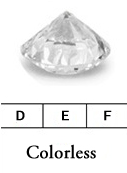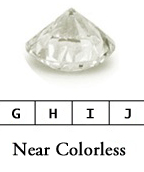800-515-1561
Diamond Color
Less is more when it comes to diamond color. Not to be confused with Fancy Colored Diamonds, the color of a diamond determines the amount of fire, or flashes of colored light, reflected by a diamond. Since color acts like a filter, the more color in your diamond the less fire will be reflected
Since truly colorless diamonds are extremely rare in the world, diamonds with the faintest tints of brown or yellow tend to fall within the normal color range. Color can dramatically affect the price of a diamond, however with diamonds less than half a carat are nearly impossible to differentiate when they fall within the top five or six color ranges.
The GIA (Gemological Institute of America) uses a standardized rating scale of starting from D, being the highest quality, and ending with Z, the lowest. As you can see from the below diagram, the color between D and H are very similar but as you move past the nearly colorless range the color within a diamond increases exponentially and is quite noticeable.

 The color scale rates D color as Absolutely Colorless. It is the highest color grade on the GIA color scale and is extremely rare in diamonds.
The color scale rates D color as Absolutely Colorless. It is the highest color grade on the GIA color scale and is extremely rare in diamonds.
The next color down is E and is rated as Colorless. This means that there are only slight traces of color, which can only be detected by an expert gemologist. This is also a very rare diamond.
Continuing down the scale, F is also rated as Colorless and within the highest quality of diamond color. There is only slight color detected by an expert gemologist, but is so slight that it is still considered
Colorless.
 In the next group of high quality diamond color, GIA considers diamonds within the G-J range as Near Colorless. Within the G-H color range however, color is rarely visible to an untrained eye and usually only in diamonds above a full carat weight. These diamonds are an excellent value for their price because they offer the beautiful appearance of a colorless diamond.
In the next group of high quality diamond color, GIA considers diamonds within the G-J range as Near Colorless. Within the G-H color range however, color is rarely visible to an untrained eye and usually only in diamonds above a full carat weight. These diamonds are an excellent value for their price because they offer the beautiful appearance of a colorless diamond.
Color is an important factor in choosing the right diamond for your ring. Since color itself acts as a filter (think of the way rose colored glasses take away certain harsh or vibrant colors when looked into), the color quality is very important to diamonds because the more color your diamond has, the less fire or sparkle will be exuded from its crown. In other words, your diamond takes in light similar to a prism and reflects its colors, called fire. Fire gives a diamond its beautiful sparkle, and to ensure that you have the right diamond for you consider the following standards for color quality.
D-E-F: Colorless. This is the colorless diamond group. They are common enough to be found in any store, but still command the highest prices. D and E show virtually no color. F starts to show the very slightest of color and is the transitional color to the next group.
G-H-I: Near colorless. This is the near colorless group. If you are looking for value when you shop, ask to see stones from this group. These diamonds begin to exhibit a very light shade of color, but it is hard to detect in mounted stones.
J-K-L-M: Faint yellow. This is the group that begins to show slight yellow color which may be noticeable from the top of the stone and even more from the sides.
To ensure highest quality in all our products, Wedding Bands Wholesale does not work with diamonds beyond H color and all of our diamonds are graded for color prior to mounting, unless requested otherwise.
At Wedding Bands Wholesale Inc. we only use the highest range of quality diamonds and chose not to deal in diamonds below the G-H color range, on our products (not to be confused with loose diamonds). We believe in superior color and quality for all of our customers at our unbeatable manufacturer prices.

